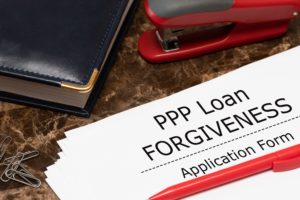Many Arizona businesses and nonprofits received SBA Paycheck Protection Program (PPP) loans to maintain their payrolls. The PPP loan proceeds must be used for eligible purposes, originally within 8 weeks and extended to 24 weeks, in order to be forgiven. By extending the time, small businesses have had more time to use the money and navigate uncertainties about reopening their businesses.
As more banks start accepting forgiveness applications, here are considerations for PPP applicants looking to obtain maximum forgiveness:
Organize and Retain the Required Documentation
Regardless of whether an applicant applies for forgiveness using the standard forgiveness application or 3508EZ (EZ Form), the applicant is required to attach or retain numerous documents. These requirements vary slightly depending on which application form, and they include:
- Support for compensation paid to employees (third-party payroll reports or bank statements).
- Support for employee compensation tables 1 and 2, including the related FTE and wage reduction tests, and safe harbor calculations.
- Documentation of employee resignations or job refusals, or support if the PPP applicant was unable to operate during the pandemic (safe harbor).
- Documentation of the number of FTE employees for the applicant’s chosen reference period.
- Support for non-payroll expenses (invoices, amortization schedules, cancelled checks).
- Support that non-payroll expenses were based on agreements that pre-date 2/15/2020.
- Tax forms (or equivalent) for periods that overlap the applicant’s covered period (for example Form 941 and state quarterly business filings).
- Documentation supporting disbursements for health insurance and retirement plans.
These requirements can be found on page 4 of the 3508EZ Instructions or page 6 of the standard forgiveness application instructions. SBA lenders may have further requirements for applicants than those listed above. Applications are subject to inspection and applicants should retain copies of these supporting documents for 6 years after the date of forgiveness or PPP loan repayment.
Do Not Wait Too Long
We recommend that PPP borrowers seek and obtain forgiveness before December 31, 2020. By acting promptly, there will be greater clarity in tax planning, financial forecasting, and budgeting. Businesses may also be able to include the forgiveness of the PPP loan as income in their financial statements and not show a liability at year-end, making their reported financial position stronger. This could help a business meet its loan covenants in spite of tough economic conditions in some industries.
Watch Out For More Changes
The SBA and other regulators continue to develop more regulations. Some of these have helped borrowers and answered questions, while others have created more uncertainty. Recent regulations include:
- Applying before the end of the covered period ratably reduces the applicant’s maximum eligible compensation for each employee.
- Defining an owner-employee for an S-Corporation and C-Corporation as someone who owns 5% or more of a corporation.
- Limiting forgiveness of rental payments made to a related-party to the related party’s mortgage interest.
There are also several key areas that remain unclear for both financial and tax reporting purposes, which include:
- Congressional action on establishing a threshold for automatic forgiveness.
- The non-deductibility of underlying expenses and the timing of reporting the forgiveness.
Our PPP task force is familiar with the loan forgiveness application and can answer questions. Contact Mark Dreher, Randy Brammer, or Barry Graham about your situation.